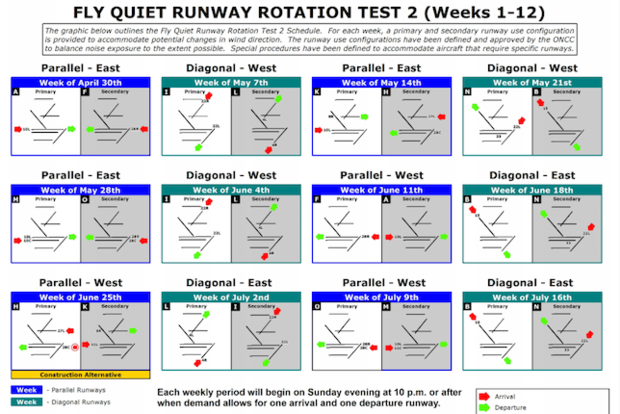
O'HARE — A key committee voted on Friday to extend a program aimed at spreading the burden of overnight jet noise around O'Hare Airport, adding minor tweaks to a schedule already in effect until July.
The third round of the Fly Quiet Runway Rotation test, slated to run from mid-July to mid-October, would steer planes away from a diagonal runway that's set to be decommissioned in early 2018. The plan would instead send those flights along other diagonal runways, still largely avoiding the skies over the city's Northwest Side.
Last year, the O'Hare Noise Compatibility Commission approved the first runway rotation program in the face of widespread demands that the city temper the noise from low-flying planes. Between July and December, the program directed overnight flights to change their takeoff and landing paths every week, ideally keeping any one neighborhood from being pummeled for too long.
Then, earlier this year, the commission approved a 12-week follow-up program to run between April 30 and July 16. A full schedule is posted online showing when each neighborhood and suburb will face overnight noise.
 A schedule showing runway rotations during the second round of the Fly Quiet test, which runs until July 16 this year. [Chicago Department of Aviation]
A schedule showing runway rotations during the second round of the Fly Quiet test, which runs until July 16 this year. [Chicago Department of Aviation]
 The third round of the test, set to run from July to October, would switch out two rotation patterns to exclude a diagonal runway that's set to be decommissioned next year. [Chicago Department of Aviation]
The third round of the test, set to run from July to October, would switch out two rotation patterns to exclude a diagonal runway that's set to be decommissioned next year. [Chicago Department of Aviation]
After the program expires in October, aviation officials will draw up a new rotation schedule that can span the period between the diagonal runway's decommissioning next spring and the introduction of a new east-west runway coming in late 2020, according to Aaron Frame, a deputy commissioner for the Chicago Department of Aviation. Federal law mandates that any rotation lasting longer than six months would have to emerge from an extensive "environmental impact study" of noise and flight patterns.
Frame said on Friday that testing a rotation that excludes the soon-to-be-closed runway would give researchers a better idea of how to craft the longer-term plan.
"Once we're in that 2½-year period, we're in it ... and we want to have all the information we need on a rotation with only five runways," Frame said. "It's one thing to try and model that situation in a computer, but being able to look at people's actual experiences is another."
Al Rapp, a representative of the anti-noise Fair Allocation in Runways coalition, spoke out against the plan Friday, telling the commission that redirecting flights to other airports or "capping" overnight flights at O'Hare may be the only way to quiet the skies in the long term.
"We're not asking you to shut down the airport at night — we're just asking you to manage overnight flights at sustainable levels," Rapp said. "Is it too much to ask for a person to be able to put his head on a pillow and get a good night's sleep?"
But since the Airport Noise & Capacity Act shifted more responsibility to federal regulators in 1990, it would take an act of Congress to turn pilots away from the airport after hours, according to Cathy Dunlap, who represents the city's 41st Ward on the commission.
And with the diagonal runway's fate having been sealed more than a decade ago, activists have little choice but to make do with the routes being offered, Dunlap said.
"It's a hard call, because you don't have that runway, but I think ultimately it's better to have a test," she said.
The full commission is scheduled to vote on the test extension during its next meeting on June 2.



















